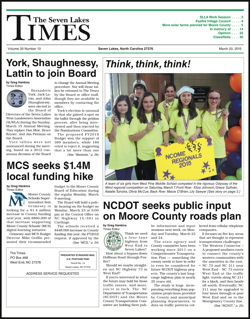 After years of saving, and studying, and planning, the Seven Lakes Landowners Association [SLLA] Board of Directors is ready to approve a plan for paving the roadways in Seven Lakes North and South.
After years of saving, and studying, and planning, the Seven Lakes Landowners Association [SLLA] Board of Directors is ready to approve a plan for paving the roadways in Seven Lakes North and South.
President Bob Darr laid out the plan, which stretches over the next sixteen years, during the Board's Monday, June 11 work session, using a neatly hand-lettered flip chart and color-coded maps. [Download a copy here.]
Driving the plan is a comprehensive study of the roadways conducted late in 2011 by the engineering firm S&ME, which assigned a "serviceability rating" to every segment of the street network. Asphalt with little usable life left was assigned a rating of 2.0. Segments in better shape, but with still less than five years of life left, were assigned a rating of 2.5. Other segments were rated 3.0, 3.5, or 4.0, with that last score reserved for roads paved relatively recently, with an expected life of 15 to 20 years.
In addition, S&ME identified forty-eight areas with extensive tree root damage -- e.g., along Dogwood Lane -- and twenty-nine other areas suffering severe fatigue. Both types of damage will require extensive subsurface work and/or patching prior to any repaving.
Phase 1 of the plan that Darr presented would patch those severely damaged areas and resurface all the roads rated 2.0 and 2.5 -- a total of 4.25 miles -- at an estimated cost of $567,500. That total includes $3,000 to place speed lifts, also known as speed "humps," in six locations.
Four years later, half of the roads rated 3.0 would be resurfaced (approximately 6 miles), with the other half paved four years after that. Twelve years out, the 3.5 rated roads would be addressed, with the roads currently rated 4.0 addressed in sixteen years.
"And, at that point, we are back to Phase 1 again," Darr said.
Restricted reserves will fund the project
Reviewing the history of the SLLA Board's efforts to build a savings account for road repaving, Darr said the first road fund was established in 2006, with the goal of saving $55,000 each year for that purpose.
In 2009, the $200,000 then in the road fund was designated a "restricted reserve" that could be used only for roads and state-mandated dam repairs. That same year, the membership approved a dues increase dedicated to the restricted reserve. Dues increased by $50 in 2009 and by another $50 the following year. Each year since, $100 of each member's annual dues have been deposited in the restricted reserve account.
The Association currently has $622,000 in the account, enough to cover the anticipated $567,500 cost of Phase 1 of the road repaving plan.
Treasurer Conrad Meyer said the $100 in restricted dues adds roughly $125,000 to the fund each year -- hence the four year wait between each phase of the repaving project.
Two types of repaving planned
The plan is to use two different repaving techniques in Phase 1, which will give the Board and the membership an opportunity to determine which is the best option for the remainder of the community's roads.
Providing a primer on road resurfacing techniques, Darr explained that the recent repaving of Seven Lakes Drive used an application called "slurry," in which a liquid asphalt sealer is used to coat the road, providing a surface with a two-to-three year expected life.
An application known as BST -- Bituminous Surface Treatment -- with a four-to-seven year expected life involves spreading tar, topping that with chips of gravel, rolling it, and then repeating the process. This produces a rougher surface, like that on MacDougall Drive in front of Carolina Car Care.
"Cape Seal" combines the two techniques. Tar is spread, topped with gravel, rolled, and then topped with slurry, producing a smoother surface with a six-to-eight year expected life.
The fourth repaving option process uses an application of BST topped with one-and-one-quarter inches of asphalt, yielding an expected life of eight-to-ten years.
Darr said there is some debate in the paving community about whether Cape Seal or BST plus asphalt is the better solution. Both options will be used on different sections of SLLA streets in Phase 1 of the repaving project.
"When we get to Phase 2," Darr said, "we will be able to look at four-year-old surfaces that we have and decide which way we want to go. There is no major difference in design life, but there is a difference in rideability -- one will be noisier than the other. We don't know which one of those two is the best. This will give us a chance to understand."
Darr indicated that there is a difference in the cost of the various applications, but he declined to address those in a public meeting.
Roads in surprisingly good shape
Darr said the S&ME engineers were very surprised at the relatively good condition of SLLA roads, given their age and construction.
There is no large gravel providing the standard thick base for the roadways, but rather hard packed soil and sand, with asphalt laid over that. Yet the roads have held up well.
Given that, the Association may be able to get more years of use out of the repaved roads than the standard design life suggests, Darr said, noting that the interior streets are subjected to relatively little heavy truck traffic.
The Board voted unanimously to move approval of Phase 1 to the open meeting scheduled for Wednesday, June 25. Darr explained that the current Board cannot dictate the decisions of future Boards, and so will only approve Phase 1 of the plan, though the expectation is that future Boards will carry on the work.
